Pictures 01 + 02
Time 0:00
Temp 10C
The following is added to a 5000ml flask:
1200g of Aldehyde Oxime
20g Nickel Acetate
2500ml of Toluene
500ml of Xylene
Heating mantle controller turned up to 50%
Water pump turned on for condenser
03
2:00
101C
Foil added to adapters
Controller turned down to 40% because of foaming
04
3:00
106C
Controller turned back up to 50%
05
4:00
108C
Foil added to flask
06
5:30
130C
Foil removed
Controller turned up to 100%
07
5:45
135C
Controller turned off
~2200ml of Non-Polar and ~300ml of Polar solvent have been distilled off, leaving ~800ml of NP solvent left in the reaction.
08
6:20
118C
Controller turned up to 100%
09
6:30
132C
Controller turned off
At this point a very exothermic reaction begins and the temperature climbs without added heat. The condensate running down the inside of the flask dissolves the Nickel Acetate stuck to the side of the flask and sizzles when it hits the solvent.
6:45
135C
7:45
118C
Controller turned up to 100%
10
8:30
137C
An additional ~400ml of Non-Polar solvent have been distilled of leaving ~400ml left in the reaction vessel.
Controller turned off
11
9:50
108C
12
10:00
Pour contents into a bucket of cold water
Time 0:00
Temp 10C
The following is added to a 5000ml flask:
1200g of Aldehyde Oxime
20g Nickel Acetate
2500ml of Toluene
500ml of Xylene
Heating mantle controller turned up to 50%
Water pump turned on for condenser
03
2:00
101C
Foil added to adapters
Controller turned down to 40% because of foaming
04
3:00
106C
Controller turned back up to 50%
05
4:00
108C
Foil added to flask
06
5:30
130C
Foil removed
Controller turned up to 100%
07
5:45
135C
Controller turned off
~2200ml of Non-Polar and ~300ml of Polar solvent have been distilled off, leaving ~800ml of NP solvent left in the reaction.
08
6:20
118C
Controller turned up to 100%
09
6:30
132C
Controller turned off
At this point a very exothermic reaction begins and the temperature climbs without added heat. The condensate running down the inside of the flask dissolves the Nickel Acetate stuck to the side of the flask and sizzles when it hits the solvent.
6:45
135C
7:45
118C
Controller turned up to 100%
10
8:30
137C
An additional ~400ml of Non-Polar solvent have been distilled of leaving ~400ml left in the reaction vessel.
Controller turned off
11
9:50
108C
12
10:00
Pour contents into a bucket of cold water




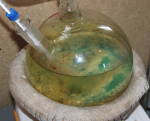
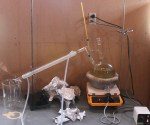
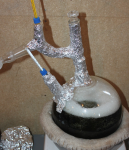
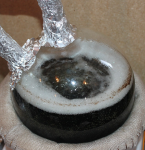
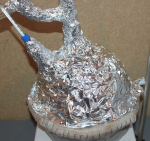
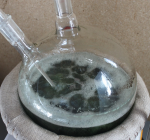

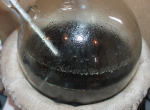

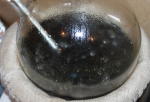

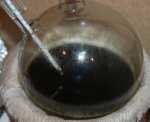
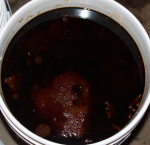


 I completed the oximation using 1 gallon of methanol, 2kg aldehyde, 2kg hydroxylamine hydrochloride, and made neutral using sodium bicarbonate. After 12hrs of stirring no aldoxime precipitated. I was left with a giant green blob and the bottom of the flask which is not unusual from what I've read. The consistency had changed to almost slime, viscous. I figured the reaction is a success. I washed it a few times with water and proceeded to the beckmann rearrangement.
I completed the oximation using 1 gallon of methanol, 2kg aldehyde, 2kg hydroxylamine hydrochloride, and made neutral using sodium bicarbonate. After 12hrs of stirring no aldoxime precipitated. I was left with a giant green blob and the bottom of the flask which is not unusual from what I've read. The consistency had changed to almost slime, viscous. I figured the reaction is a success. I washed it a few times with water and proceeded to the beckmann rearrangement. The end results from the effort applied
The end results from the effort applied 
